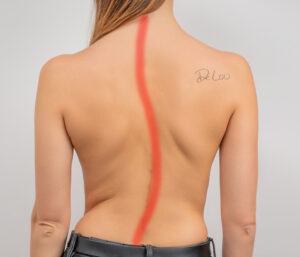What is scoliosis & what are the available options?
by Dr. Aaron Vela
Have you been told by a healthcare professional that you or your child has scoliosis?

Scoliosis care at Jacobs Chiropractic Acupuncture. Call (207) 774-6251
What is scoliosis? Scoliosis is an abnormal curvature of the spine that is seen in a front to back, or back to front, view of the spine. The spine normally has 3 curves that can be seen when looking at the spine from the side. These normal curves are in your neck, your mid back, and your lower back. These normal curves function as shock absorbers for the body. Scoliosis is a lateral curve in the spine or more easily put, a left or right curve in the spine that may lead to premature degeneration, pain, postural abnormalities, and restricted mobility.
There are generally 5 different types of scoliosis.
Congenital – meaning the person was born with it.
Neuromuscular – which is caused by neuromuscular (nerve and muscle) conditions and their impact on the body, such as cerebral palsy.
Degenerative – which occurs when the joints between vertebrae in the back of the spine have deteriorated.
Functional – which is more or less a temporary type of scoliosis that can be due to difference in leg lengths and other tone issues.
Idiopathic – which is a scoliosis that can’t be defined as any of the other types of scoliosis. This is the most common type of scoliosis.
There are generally 4 types of treatments for scoliosis.
Observation – which is a wait and see method that doesn’t involve any intervention.
Bracing – which is kind of like this plastic vest mechanism that you wear around your torso. This method is only used when a person has a lot of growing left to do and doesn’t correct scoliosis but aims to slow its progression.
Surgery – which is used when the scoliosis is severe. It is the most invasive of all of the treatments and involves screws, hooks, and a rod being placed in and on the spine, which then involves a mechanical straightening of the spine as much as possible. The fused portion makes the spine permanently stiff.
Scientific exercises – which involves utilizing the muscles around the spine to create somewhat of a natural brace in order to slow the progression of the scoliosis.
You should know that scoliosis can be mild, meaning the angle of the lateral curve is less than 20 degrees. Scoliosis may be moderate, meaning the angle of the curve is between 25 and 40 degrees. Scoliosis may be severe, meaning the scoliosis is 50 degrees or more.
Bracing can be used in young people who are still growing if their scoliosis is between 30 and 50 degrees. Bracing and exercises, like “auto-correction”, are generally the best combination for those young people who are not candidates for surgery. For adults who are done growing with mild or moderate scoliosis, scientific exercises are still a feasible option to prevent the scoliosis from getting worse as they get older.
Auto-correction is a protocol of researched exercise that healthcare professionals will use to get the patient to engage specific muscles in specific areas to “auto-correct” the abnormal curves in the spine. So for example, let’s say the scoliosis causes the left shoulder to be lower than the right. The first step would be to use the muscles to raise the lower shoulder until it’s even with the other. Next let’s say the spine in the upper back between the shoulder blades curves to the right. The next step would be to engage muscles in the upper back to shift that area to the left as much as possible while still holding the shoulders level. This process is repeated down the spine, engaging necessary muscles to bring the misalignments as close to alignment as they will go.
Once all muscles are engaged, this is the auto-correction position that the person practices about once per waking hour until they build the muscle memory to quickly auto-correct their body position. The next steps involve functional movement exercises such as walking in place, pushing a broom handle into the ground while seated, doing wall falls and wall push ups, and specific balance exercises in the auto-correction position in order to reinforce those muscles being engaged. This approach is a process and could possibly prevent the need for surgery later in life if done routinely and correctly.
If this post did not answer all of your questions about scoliosis, please feel free to contact us by calling (207) SPINAL-1 to speak to one of our spine experts.
Dr. Aaron Vela is a doctor of chiropractic licensed in Maine. He is the associate doctor at Jacobs Chiropractic Acupuncture Center in Portland, Maine. The office was established in 2003, and Dr. Aaron has been at the practice since August of 2021.
